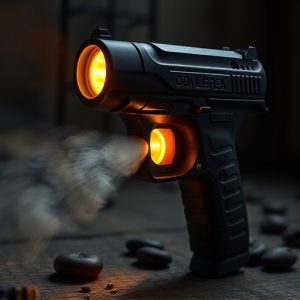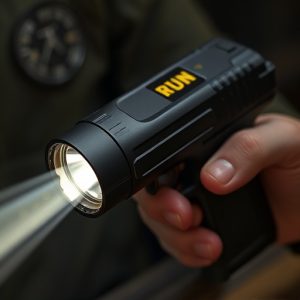Decoding Runt Stun Gun Voltage: Performance and Legal Boundaries
A runt stun gun is a compact yet potent personal safety device capable of delivering a powerful ele…….
A runt stun gun is a compact yet potent personal safety device capable of delivering a powerful electrical current for self-defense. Its effectiveness, as with any electroshock weapon, is primarily determined by its voltage output, which can range from 450,000 to over 900,000 volts. A high voltage is essential for incapacitating an attacker by disrupting their muscular and nervous systems. However, it's crucial to understand that while voltage is a critical factor, proper usage, adherence to legal regulations, and battery maintenance are equally important. Runt stun guns must be designed within legal voltage limits and should be chosen in accordance with state or local laws. Users must also consider the device's amperage and electrode design for effective use. It's imperative to follow manufacturer guidelines to ensure safety and legality, as well as to maintain the stun gun's performance through regular maintenance. Always remember that a runt stun gun can be an effective self-defense tool when used responsibly and correctly.
When it comes to personal defense devices, the effectiveness of a stun gun often hinges on its voltage. In this article, we delve into the characteristics and performance of so-called “runt” stun guns—compact yet potent self-defense tools. We explore the scientific principles that govern their operation, how voltage impacts their efficacy, and the best models in the market. Additionally, we address the critical legal aspects surrounding their use, ensuring you stay within compliance. Finally, we provide expert advice on maximizing your runt stun gun’s potential for optimal safety and effectiveness. Join us as we navigate the world of runt stun guns and their voltage capabilities.
Understanding Runt Stun Gun Voltage: The Basics
When considering personal safety devices, a runt stun gun emerges as a viable option for individuals seeking a compact yet effective self-defense tool. Unlike its larger counterparts, the runt stun gun is designed to be highly portable while still delivering a powerful electric shock to incapacitate an attacker. The voltage of a stun gun is a critical factor determining its stopping power. Typically, stun guns are measured in terms of microcoulomps or shock level rather than voltage alone; however, the voltage is often cited as a marker of strength. A runt stun gun, despite its diminutive size, may boast an average voltage that ranges from 450,000 to 900,000 volts. This high voltage, combined with the device’s electrically charged probes, creates a strong electrical current that can effectively deter aggressors. Understanding the basics of runt stun gun voltage is essential for users to assess the device’s capability and to use it confidently in self-defense situations. It’s important for users to familiarize themselves with their state or local regulations regarding stun guns, as they may vary by jurisdiction. Additionally, users should be aware that while the voltage is a significant aspect of a stun gun’s performance, proper aiming, correct handling, and legal compliance are equally important for effective use.
The Science Behind Stun Guns: How Voltage Affects Efficacy
Stun guns, often referred to as electroshock weapons, rely on a high-voltage electric current rather than lethal force to incapacitate an attacker. The efficacy of these devices is primarily determined by their voltage output. A runt stun gun, while potentially smaller in size compared to its counterparts, can still deliver a powerful shock if it possesses an adequate voltage. The science behind the effectiveness of stun guns lies in the rapid deployment of a high-voltage, low-ampere electrical charge. This charge disrupts the normal function of the victim’s muscular and nervous systems, causing neuromuscular incapacitation. The voltage is a critical factor; it must be sufficient to overcome the natural resistance of the human body without being so high as to cause harm or even death. Typically, stun guns operate at voltages ranging from 400,000 to over 500,000 volts. A runt stun gun that falls within this range can be just as effective as larger models, provided the current is properly channeled and the electrodes are of adequate size and shape to deliver the charge effectively. Users should always follow manufacturer guidelines and understand the limitations and proper use of their device to ensure safety and legal compliance. The right balance of voltage, amperage, and design is essential for a stun gun’s performance, making it a reliable self-defense tool when used responsibly.
Comparing Runt Stun Gun Models: Voltage Variations and Performance
When assessing runt stun guns for personal defense, understanding the voltage outputs of various models is crucial for determining their effectiveness and suitability for self-defense. Runt stun guns come in a range of voltages, which can significantly influence their stopping power against an assailant. Typically, higher voltage models are more powerful and capable of delivering a stronger electric shock, which can be disorienting or incapacitating to an attacker. However, the effectiveness of a stun gun also depends on other factors such as amperage, battery strength, and electrode design. For instance, a runt stun gun with 6 million volts may not deliver the same level of power as one with 95 million volts if other components are substandard. Therefore, it’s important to consider how these voltage variations impact the overall performance of the device in real-world scenarios. Users should evaluate not just the advertised voltage but also how that voltage is harnessed and delivered through the unit’s contacts to ensure maximum effectiveness when confronted with a threat. Additionally, legal considerations and state laws governing stun gun use must be taken into account, as these can vary and affect which model may be most appropriate for individual defense needs.
Legal Considerations of Runt Stun Gun Usage: Voltage Regulations and Compliance
When considering the legal landscape surrounding stun guns, it’s crucial to focus on voltage specifications as they play a pivotal role in compliance and legality. Runt stun guns, often characterized by their lower voltage output compared to their full-sized counterparts, navigate a unique set of regulations. These devices typically generate less voltage, which can influence their effectiveness as well as their conformity with state and federal laws. For instance, some jurisdictions cap the allowable voltage for civilian stun guns within a specific range, necessitating that runt models adhere to these limitations. Users must be aware of these restrictions to ensure legal possession and use. Manufacturers of runt stun guns are tasked with designing their devices to comply with these regulations, ensuring that the voltage output is within permissible limits. This compliance is not only a matter of legality but also one of user safety; excessive voltage can pose risks to individuals and bystanders alike. Therefore, it’s imperative for consumers to verify both the legal status of runt stun guns in their area and the device’s voltage output to avoid unintended legal infractions or unsafe practices. Understanding the voltage regulations is a critical aspect of responsible ownership and use of runt stun guns.
Tips for Safely Operating Your Runt Stun Gun: Maximizing Voltage Effectiveness
When deploying your runt stun gun for self-defense, understanding how to maximize its voltage effectiveness is crucial for deterring potential threats. To ensure optimal performance, always keep the battery fully charged as a low charge can diminish the device’s output voltage and rendering it less effective. Inspect your stun gun regularly to confirm that the electrode contacts are clean and free of debris, which can also impact its ability to deliver a sufficient electrical charge. Additionally, consider the design of the runt stun gun; models with higher amperage can deliver more powerful shocks, making them more formidable in self-defense situations. When using your stun gun, aim for large muscle groups to provide the best incapacitating effect. The concept behind a stun gun is to create a strong enough electrical circuit between the probes to disrupt the body’s muscular control by stimulating muscles and nerves, leading to an intense sensation that can immobilize an attacker temporarily. Always adhere to local laws and regulations regarding the use of stun devices, as they may vary by jurisdiction. Proper handling and understanding of your runt stun gun will not only ensure your safety but also the effectiveness of this self-defense tool in critical moments.


